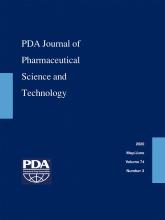Abstract
Investigations into environmental monitoring (EM) excursions can be prolonged and do not always result in clear root causes or corrective and preventative actions. This article outlines how biofluorescent particle counting (BFPC) can be used in investigations to eliminate the inherent delays of culture-based methods. The application for investigations supplements routine EM, acting as a risk-reduction tool enabling real-time detection of viable microorganisms in air samples and supporting root cause analysis and remedial actions. The article includes guidance on how to use the technology, a real case study involving a mold excursion, and examples of business benefits achieved by various companies.
- © PDA, Inc. 2020
PDA members receive access to all articles published in the current year and previous volume year. Institutional subscribers received access to all content. Log in below to receive access to this article if you are either of these.
If you are neither or you are a PDA member trying to access an article outside of your membership license, then you must purchase access to this article (below). If you do not have a username or password for JPST, you will be required to create an account prior to purchasing.
Full issue PDFs are for PDA members only.
Note to pda.org users
The PDA and PDA bookstore websites (www.pda.org and www.pda.org/bookstore) are separate websites from the PDA JPST website. When you first join PDA, your initial UserID and Password are sent to HighWirePress to create your PDA JPST account. Subsequent UserrID and Password changes required at the PDA websites will not pass on to PDA JPST and vice versa. If you forget your PDA JPST UserID and/or Password, you can request help to retrieve UserID and reset Password below.






